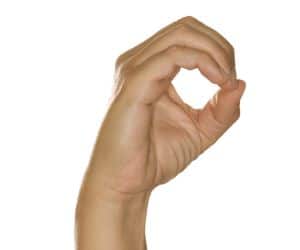
Another common hand sign among teens is the "shaka," which is made by holding up the thumb and pinky finger while keeping the other fingers curled down. This gesture, which originated in Hawaii, is often used among teens to indicate "cool," "good vibes," or to greet a friend.
teen hand signsThe "rock on" hand sign, which is made by holding up the index and pinky fingers while keeping the other fingers curled down, is often used among teens to indicate rock music, support or agreement.
Another common hand gesture is the thumbs up. This gesture is often used to indicate approval, agreement, or support. The thumbs up can be used in a variety of contexts, from expressing satisfaction with a job well done to signaling that a plan or proposal has been accepted. This gesture is widely recognized and understood in most cultures, making it a useful tool for communication in a variety of settings.
The "I love you" hand sign, which is made by forming the letters "I" and "L" with the thumb and index finger and "Y" with the thumb and pinky finger, is often used among teens to indicate love or affection.

The fist bump, made by touching the knuckles of one's fist against another person's fist, is a casual gesture of greeting or agreement. This gesture is thought to have originated in the African American community and is often associated with sports and hip-hop culture.
One of the most universally recognized hand gestures is the thumb's up, which is used to indicate approval or agreement. This gesture has its origins in ancient Rome, where it was used to signal that a gladiator should be spared. Today, it is often used in casual conversation and social media to express support or endorsement.
The "rock on" hand gesture is made by holding up the index and pinky finger and is used to express agreement or support for music.
The "hang loose" hand sign, which is made by holding up the thumb and pinky finger while keeping the other fingers curled down, is often used among teens to indicate relaxation, chill or a casual attitude.
In conclusion, hand gestures play a vital role in human communication and are an integral part of urban culture. From the thumb's up to the shaka sign, these gestures convey a wide range of emotions, ideas, and intentions. Understanding the meaning and significance of different hand gestures can help us communicate more effectively and build stronger connections with others.

First, let's start with the most basic hand gesture: the wave. A wave is a simple gesture that is used to greet or acknowledge someone. It can be done with one hand or both hands and can vary in intensity, from a casual, lazy wave to a more enthusiastic, vigorous wave.
In conclusion, hand gestures are a rich and complex form of communication that convey meaning in various cultures and contexts. They range from simple gestures like a wave or a thumbs up to more complex gestures like sign language. Each gesture has its own nuances and subtleties that make them fascinating and versatile tools for human communication. Whether you are trying to express emotions, convey instructions, or tell a story, hand gestures are an essential part of the human experience.
The fist is a powerful hand gesture that is often associated with strength and determination. It is used to indicate power, aggression, or to show support for a cause. It is also used as a symbol of resistance and protest.
Another common hand gesture is the thumbs up. This gesture is generally used to indicate agreement, approval or to show that everything is okay. The thumbs up is a universal sign that is understood in many cultures and is often used in the context of social media and instant messaging.
Basic hand gestures include gestures such as pointing, waving, beckoning, and thumb-up/thumb-down. These nonverbal cues can convey a wide range of messages and can be used in various social contexts. They are an integral part of human communication, and their meanings can vary widely depending on cultural and individual differences.
Inappropriate hand gestures are those that are considered offensive, insulting, or vulgar in a particular culture or context. Examples include the middle finger, which is considered highly disrespectful and offensive in most cultures, the okay sign, which can be considered racist or offensive in some places, and the fig sign, which is considered vulgar in some cultures. Additionally, there are hand gestures that can be considered culturally insensitive or disrespectful such as the hand-heart gesture and the "thumbs up" gesture which can be offensive in some cultures. It's important to be aware of the cultural and social norms in any given context before using any hand gestures to avoid inadvertently causing offense.
Holding two fingers down can hold different meanings depending on the context and culture. In some sports, it is a sign of a referral to the video assistant referee. Additionally, it can be used as a symbol of disapproval or rejection, opposite to holding up two fingers which can be considered as a symbol of peace and goodwill. It can also be used as a sign of disappointment or defeat. As with any hand gesture, the meaning can vary and it's important to be aware of the context and cultural implications before using this gesture. It's important to note that in certain cultures, it might not have a specific meaning, and it's best to be cautious and respectful when using any hand gestures.
Holding up one finger can hold different meanings depending on the context and culture. In American Sign Language, it represents the number one. In some sports, it's a sign of a referral to the video assistant referee. Additionally, it can be used as a symbol of singularity or unity, as in the phrase "one for all, and all for one." On the other hand, it can also be considered as an offensive gesture in some cultures, as it can be interpreted as an expression of dominance or superiority. As with any hand gesture, the meaning can vary and it's important to be aware of the context and cultural implications before using this gesture.